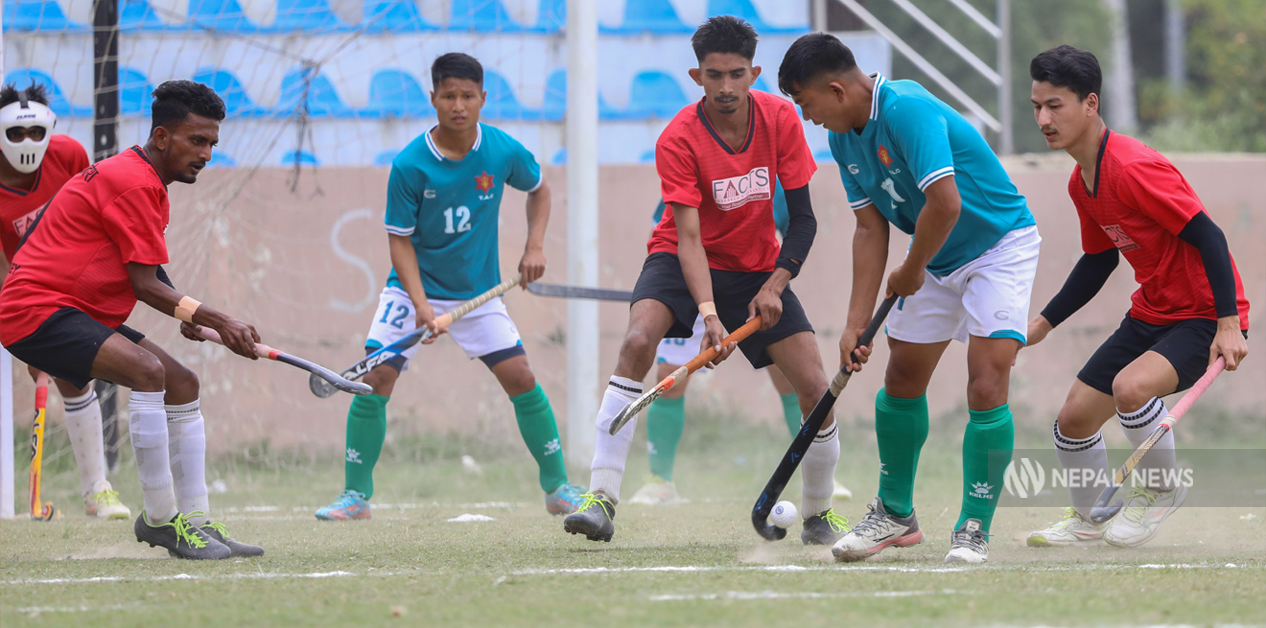

KATHMANDU: Bagmati Province hockey player Bishal Karki had not held a ‘stick’ since playing the 9th National Games in Pokhara in December 2022. He was seen at Chyasal Football Ground in Lalitpur on May 6 for the National Men’s and Women’s Hockey Competition.
“I had come to Kathmandu for an interview for going abroad. Friends told me there’s a game, so I came just to meet them,” said Karki.
For him, the competition became more of an excuse to meet friends than to play, reflecting hockey’s declining state. “Competitions in other sports happen regularly and bring money, but hockey has neither. That’s why I chose to go abroad to support my family,” he said with a grim expression.
Many players like Karki have already migrated to Malaysia, Qatar, Japan, and Australia. Some promising national team players work in hotels, construction, and as drivers. Others continue to play despite challenges, says Bagmati Province captain Arjun Khadka. “We are supposed to play on turf (artificial grass) but are made to play on football grounds. We play as best we can, but there’s no money,” he adds, “When there’s no money, families question why we should continue.”
Introduced by students from India
Hockey has been popular in India and Pakistan since the 19th century. India won six Olympic golds from 1928 to 1980, while Pakistan won the first World Cup in Barcelona in 1971.
Nepal, influenced by both neighbors, adopted the sport through students studying in Kolkata, Dehradun, Lucknow, and Darjeeling during the Rana era. They played at the Nepal Army headquarters during holidays. The Hockey Association of Nepal was registered in 1954.
Hockey thrived from 1976-1984, with competitions held regularly. The second National Games in Pokhara in 1983 included hockey for the first time.
Nepal’s first national team captain Devendra Raj Kandel grew up playing hockey in Lucknow. Although selected for India’s national team training as a goalkeeper, he was dropped due to citizenship issues. He refused to renounce Nepali citizenship, returned home, and led Lumbini Zone to a gold medal at the 1983 Pokhara games.
Initially, hockey was limited to Kathmandu with teams like Kathmandu Red & Yellow, Mahavir, Godawari Alumni Association (GA), Boys Union, St. Xavier, Budhanilkantha, Tribhuvan University, Tri-Chandra College, and Amrit Science College. Hockey enthusiasts included Nepal Hockey Association president Anil Sharma and former president Umeshlal Shrestha, both from Godawari Club, practicing at Tundikhel.
British and Canadian embassy staff also formed teams, and St. Xavier and Budhanilkantha schools contributed players, attracting athletes struggling in football or cricket.
The first national coach, Ashok Pandey, notes, “Hockey was popular for its artistic style. Playing at Tundikhel almost always led to fights.”
Even members of the royal family, including ex-King Gyanendra and his brother Dhirendra Shah, learned hockey at St. Joseph School, Darjeeling, and played with the public at Tundikhel during holidays.
Short golden era
Hockey’s golden era began in 1976 but was short-lived. Rajendra Karki introduced the sport in Biratnagar. Ranjan Thapa, chief hockey coach at the National Sports Council, recalls learning from Karki. Hockey competitions were strong until 1983, when Pokhara hosted the second national games with teams from six zones. Lumbini Zone, including Kandel, won gold, achieving a hat-trick by 1983.
Nepal made its international debut at the 7th South Asian Games in Chennai under captain Bijayendra Sharma (Pintu) in 1995.
The team included inexperienced players like Ashwini Adhikari and Jagat Tamata. Nepal conceded 27 goals to India and 16 to Pakistan. “If senior players had been included, results might have been better,” says Raviendra Singh.
Leadership under Shrestha used foreign trips merely for exposure. Competitions halted, and the association was inactive for two decades.
“After the SAG, we expected momentum, but mismatched leadership caused inactivity,” says Madhes Province coach Singh. Nepal’s hockey level declined while neighboring countries advanced.
Players lacked turf experience; India provided two months of turf training before the Chennai games. The association failed to utilize available opportunities. Shrestha’s 15-year inaction harmed hockey’s credibility.
Former Youth & Sports Minister Birajbhakta Shrestha withheld budgets, affecting tournaments like the Girija Prasad Koirala Men’s and Sahana Pradhan Women’s competitions. National competitions remain uncertain due to inadequate grounds.
Nepali players last trained in Pakistan in 2018 for a month. Promising talents exist, especially in South Asia, but some have switched citizenship, like 28-year-old goalkeeper Krishnabhadur Pathak, now playing for India and winning multiple medals.
Many talented players participate in Indian state-level competitions, but Nepal cannot integrate them, notes Bagmati coach Manojkumar Sharma. Returning these players could revive hockey.
Players exist, but turf and plans are lacking
Women’s teams include Nepal Army, Gandaki, Madhes, and Bagmati; men’s teams include three departmental and all provincial teams.
Only three coaches are available, and practice grounds are scarce. Younger players require years of development. “National Games occur only every two years, so teaching and development continue but are not sustainable,” says Sharma.
Nepal occasionally receives international friendly invitations but lacks its own astro turf. Players gain turf experience only through trips to India.
The association plans to send players to India for exposure. Schools in Gandaki, Madhes, Bhaktapur, Hetauda, and Humla have programs to develop players.
Dhulikhel Municipality has provided land for turf. If completed, hockey can regain its former status.